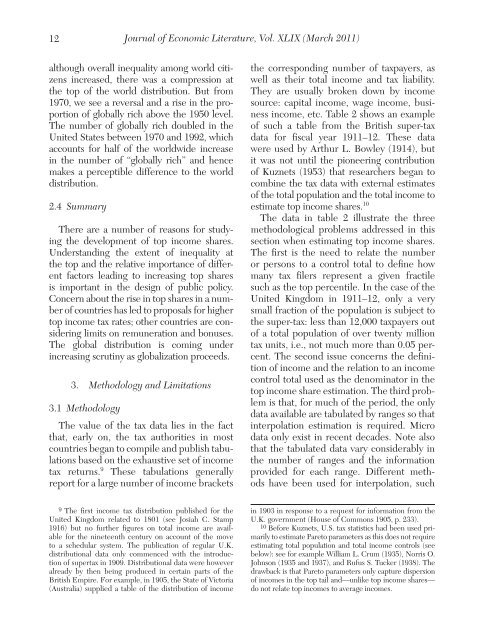"Top Incomes in the Long Run of History" with Tony Atkinson and
"Top Incomes in the Long Run of History" with Tony Atkinson and
"Top Incomes in the Long Run of History" with Tony Atkinson and
You also want an ePaper? Increase the reach of your titles
YUMPU automatically turns print PDFs into web optimized ePapers that Google loves.
12Journal <strong>of</strong> Economic Literature, Vol. XLIX (March 2011)although overall <strong>in</strong>equality among world citizens<strong>in</strong>creased, <strong>the</strong>re was a compression at<strong>the</strong> top <strong>of</strong> <strong>the</strong> world distribution. But from1970, we see a reversal <strong>and</strong> a rise <strong>in</strong> <strong>the</strong> proportion<strong>of</strong> globally rich above <strong>the</strong> 1950 level.The number <strong>of</strong> globally rich doubled <strong>in</strong> <strong>the</strong>United States between 1970 <strong>and</strong> 1992, whichaccounts for half <strong>of</strong> <strong>the</strong> worldwide <strong>in</strong>crease<strong>in</strong> <strong>the</strong> number <strong>of</strong> “globally rich” <strong>and</strong> hencemakes a perceptible difference to <strong>the</strong> worlddistribution.2.4 SummaryThere are a number <strong>of</strong> reasons for study<strong>in</strong>g<strong>the</strong> development <strong>of</strong> top <strong>in</strong>come shares.Underst<strong>and</strong><strong>in</strong>g <strong>the</strong> extent <strong>of</strong> <strong>in</strong>equality at<strong>the</strong> top <strong>and</strong> <strong>the</strong> relative importance <strong>of</strong> differentfactors lead<strong>in</strong>g to <strong>in</strong>creas<strong>in</strong>g top sharesis important <strong>in</strong> <strong>the</strong> design <strong>of</strong> public policy.Concern about <strong>the</strong> rise <strong>in</strong> top shares <strong>in</strong> a number<strong>of</strong> countries has led to proposals for highertop <strong>in</strong>come tax rates; o<strong>the</strong>r countries are consider<strong>in</strong>glimits on remuneration <strong>and</strong> bonuses.The global distribution is com<strong>in</strong>g under<strong>in</strong>creas<strong>in</strong>g scrut<strong>in</strong>y as globalization proceeds.3. Methodology <strong>and</strong> Limitations3.1 MethodologyThe value <strong>of</strong> <strong>the</strong> tax data lies <strong>in</strong> <strong>the</strong> factthat, early on, <strong>the</strong> tax authorities <strong>in</strong> mostcountries began to compile <strong>and</strong> publish tabulationsbased on <strong>the</strong> exhaustive set <strong>of</strong> <strong>in</strong>cometax returns. 9 These tabulations generallyreport for a large number <strong>of</strong> <strong>in</strong>come brackets<strong>the</strong> correspond<strong>in</strong>g number <strong>of</strong> taxpayers, aswell as <strong>the</strong>ir total <strong>in</strong>come <strong>and</strong> tax liability.They are usually broken down by <strong>in</strong>comesource: capital <strong>in</strong>come, wage <strong>in</strong>come, bus<strong>in</strong>ess<strong>in</strong>come, etc. Table 2 shows an example<strong>of</strong> such a table from <strong>the</strong> British super-taxdata for fiscal year 1911–12. These datawere used by Arthur L. Bowley (1914), butit was not until <strong>the</strong> pioneer<strong>in</strong>g contribution<strong>of</strong> Kuznets (1953) that researchers began tocomb<strong>in</strong>e <strong>the</strong> tax data <strong>with</strong> external estimates<strong>of</strong> <strong>the</strong> total population <strong>and</strong> <strong>the</strong> total <strong>in</strong>come toestimate top <strong>in</strong>come shares. 10The data <strong>in</strong> table 2 illustrate <strong>the</strong> threemethodological problems addressed <strong>in</strong> thissection when estimat<strong>in</strong>g top <strong>in</strong>come shares.The first is <strong>the</strong> need to relate <strong>the</strong> numberor persons to a control total to def<strong>in</strong>e howmany tax filers represent a given fractilesuch as <strong>the</strong> top percentile. In <strong>the</strong> case <strong>of</strong> <strong>the</strong>United K<strong>in</strong>gdom <strong>in</strong> 1911–12, only a verysmall fraction <strong>of</strong> <strong>the</strong> population is subject to<strong>the</strong> super-tax: less than 12,000 taxpayers out<strong>of</strong> a total population <strong>of</strong> over twenty milliontax units, i.e., not much more than 0.05 percent.The second issue concerns <strong>the</strong> def<strong>in</strong>ition<strong>of</strong> <strong>in</strong>come <strong>and</strong> <strong>the</strong> relation to an <strong>in</strong>comecontrol total used as <strong>the</strong> denom<strong>in</strong>ator <strong>in</strong> <strong>the</strong>top <strong>in</strong>come share estimation. The third problemis that, for much <strong>of</strong> <strong>the</strong> period, <strong>the</strong> onlydata available are tabulated by ranges so that<strong>in</strong>terpolation estimation is required. Microdata only exist <strong>in</strong> recent decades. Note alsothat <strong>the</strong> tabulated data vary considerably <strong>in</strong><strong>the</strong> number <strong>of</strong> ranges <strong>and</strong> <strong>the</strong> <strong>in</strong>formationprovided for each range. Different methodshave been used for <strong>in</strong>terpolation, such9 The first <strong>in</strong>come tax distribution published for <strong>the</strong>United K<strong>in</strong>gdom related to 1801 (see Josiah C. Stamp1916) but no fur<strong>the</strong>r figures on total <strong>in</strong>come are availablefor <strong>the</strong> n<strong>in</strong>eteenth century on account <strong>of</strong> <strong>the</strong> moveto a schedular system. The publication <strong>of</strong> regular U.K.distributional data only commenced <strong>with</strong> <strong>the</strong> <strong>in</strong>troduction<strong>of</strong> supertax <strong>in</strong> 1909. Distributional data were howeveralready by <strong>the</strong>n be<strong>in</strong>g produced <strong>in</strong> certa<strong>in</strong> parts <strong>of</strong> <strong>the</strong>British Empire. For example, <strong>in</strong> 1905, <strong>the</strong> State <strong>of</strong> Victoria(Australia) supplied a table <strong>of</strong> <strong>the</strong> distribution <strong>of</strong> <strong>in</strong>come<strong>in</strong> 1903 <strong>in</strong> response to a request for <strong>in</strong>formation from <strong>the</strong>U.K. government (House <strong>of</strong> Commons 1905, p. 233).10 Before Kuznets, U.S. tax statistics had been used primarilyto estimate Pareto parameters as this does not requireestimat<strong>in</strong>g total population <strong>and</strong> total <strong>in</strong>come controls (seebelow): see for example William L. Crum (1935), Norris O.Johnson (1935 <strong>and</strong> 1937), <strong>and</strong> Rufus S. Tucker (1938). Thedrawback is that Pareto parameters only capture dispersion<strong>of</strong> <strong>in</strong>comes <strong>in</strong> <strong>the</strong> top tail <strong>and</strong>—unlike top <strong>in</strong>come shares—do not relate top <strong>in</strong>comes to average <strong>in</strong>comes.















